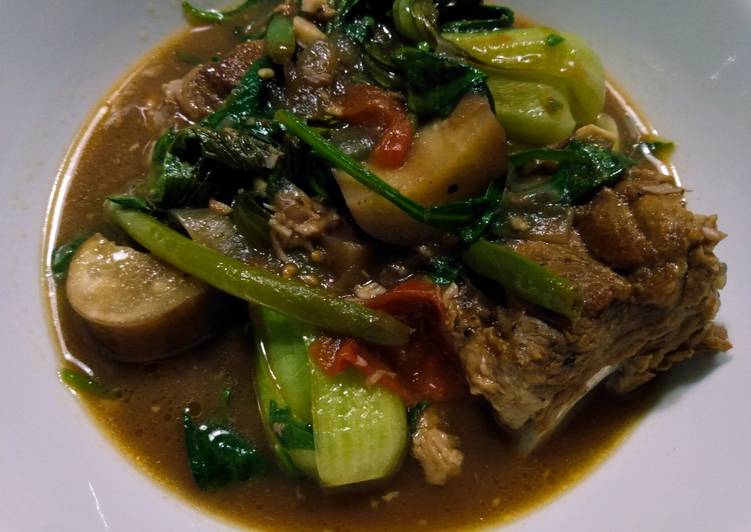
Hello everybody, I hope you’re having an amazing day today. Today, I’m gonna show you how to prepare a special dish, pork rib sinigang. One of my favorites. This time, I will make it a little bit tasty. This will be really delicious.
Pork rib sinigang is one of the most favored of current trending meals on earth. It is easy, it’s quick, it tastes yummy. It is enjoyed by millions daily. They’re fine and they look wonderful. Pork rib sinigang is something which I’ve loved my whole life.
Sinigang (Pork Spare Ribs in Sour Soup) Be the first to rate & review! This is a tangy, soupy, one-pot meal from the Philippines. It can serve as a soup and a main dish complete with vegetables and it is easy to make. Cut of Pork - pork ribs, pork belly, pork neck, and pork shoulder are the recommended cuts for sinigang.
To begin with this particular recipe, we have to first prepare a few ingredients. You can cook pork rib sinigang using 13 ingredients and 4 steps. Here is how you can achieve it.
The ingredients needed to make Pork rib sinigang:
- Make ready 1 large onion, thinly sliced
- Make ready 1 full rack pork back ribs, trimmed and cut into 2 rib segments
- Get 6 cloves garlic, roughly chopped
- Make ready 6 cups vegetable stock
- Take 4 large bay leaves
- Take 1/2 cup tamarind concentrate
- Make ready 3 tbsp fish sauce
- Get 3 Roma tomatoes, chopped
- Make ready 1 jalapeno, halved
- Take 1 large eggplant, chopped into 2 cm chunks
- Prepare 1 large handful green beans, trimmed
- Get 8 pcs baby bok choy
- Prepare 2 cups baby spinach
Season the ribs with salt and pepper and add them to the pan. Pork Ribs Sinigang or Sinigang na Buto-Buto is one of the Filipinos favorite dish. It is simply good you can prepare at your own kitchen. This Pork Ribs Sinigang recipe is made of tender and fall off the bones pork ribs with taro root (gabi) making it rich with lots of classic sinigang vegetables and soured with tamarind soup base.
Instructions to make Pork rib sinigang:
- Add a splash of veg oil to a wide, high-sided pan on medium-high heat. Add the onions and fry for 2 to 3 minutes until softened. Season the ribs with salt and pepper and add them to the pan. Sear about 2 minutes, then flip and sear about 2 minutes more. At the flip, add the garlic. As the ribs brown, move the onions and garlic around a bit so they don't burn.
- Add enough stock to the pan to cover the ribs. If more liquid is needed, just top up with water. Add the bay leaves, tamarind concentrate, and fish sauce. Bring to a simmer, then turn the heat down to medium-low. After 15 minutes, skim any foam from the surface.
- Add the tomatoes and jalapeno to the pan. Cover, and let simmer for 1 1/2 hrs until the meat is tender. Add water as needed to keep the ribs submerged.
- Remove the bay leaves and jalapeno. Add the eggplant and turn the heat back up to medium-high. Continue simmering uncovered for 5 minutes. Add the beans and bok choy and simmer another 5 minutes. Check the seasoning and add salt and freshly cracked black pepper to taste. Take the pan off the heat and add the spinach. Give the spinach a minute to wilt, then serve the soup hot with steamed rice.
It is simply good you can prepare at your own kitchen. This Pork Ribs Sinigang recipe is made of tender and fall off the bones pork ribs with taro root (gabi) making it rich with lots of classic sinigang vegetables and soured with tamarind soup base. Pork Ribs Sinigang or Sinigang is a Filipino word of "to stew". It is often associated with dishes in sour soup and different kinds of proteins or shrimps. The more traditional approach of cooking this dish is deriving their sourness from native ingredients such as tamarind or santol.
So that is going to wrap this up with this special food pork rib sinigang recipe. Thanks so much for your time. I am sure that you will make this at home. There is gonna be interesting food at home recipes coming up. Don’t forget to save this page on your browser, and share it to your family, friends and colleague. Thank you for reading. Go on get cooking!


